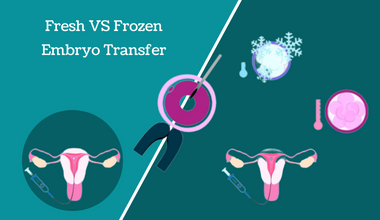There is no wonder in the improvement of technology every day, but sometimes it makes everyone wonder by making the impossible thing into the possible thing. Many couples suffer a lot without having a baby for them and providing birth to a child through technology is possible. IVF – in-vitro fertilization is the best technology to vanish the worry of non-pregnancy. There is a big confusion about fresh and frozen embryo transfer, and through this post, you will get a clear understanding of both embryo transfers.
What is embryo transfer?
It is ideal to understand the basics of embryo transfer, and it is a final step in the In Vitro Fertilization (IVF) process. The fertilized eggs are the future children, and the eggs would be removed from women’s bodies and kept in a lab for fertilization. After a certain period, the fertilized eggs (embryos) will be transferred again to the women’s uterus by safely loading those embryos into the catheter and sent to the uterus through the women’s vagina and cervix. Those embryos are kept in the embryology lab for 3-7 days for the development process.
Fresh vs frozen embryo transfers
The ovulation induction and monitoring is the common beginning step for both frozen and fresh embryo transfer. Doctors will keep the eggs out of the uterus since the uterus may have some issues or be so weak to carry the embryos. The women will have the egg retrieved by the reproductive endocrinologist once their uterus is getting ready for it. Your eggs will get fertilized with your partner’s sperm or some other donor’s sperm by the reproductive endocrinologist.
Now the embryos are ready after finishing the retrieved and fertilized, and they can be categorized as the fresh embryo and frozen embryo. If the embryos are returned to the uterus within 3-5 days, it is a fresh embryo transfer. Other hand, if the embryos are kept for years, then it is frozen embryo transfer. The success rate of frozen embryo is always higher than the fresh embryo transfer. Fresh embryo transfer occurs in stimulation time, and frozen embryo transfer occurs in the non-stimulation period.
What are the advantages of the frozen embryos transfer?
As the frozen embryo transfer has the highest success rate of giving birth to a child than the fresh embryo transfer, it is time to learn about the benefits of frozen embryo transfer.
- Pregnancy rate:
There is huge reliability in the techniques for freezing embryos, and the risk of cycles for OHSS is very less in frozen embryo transfer. The possibility of success is somehow the same for both fresh and frozen embryos. In such cases, the frozen embryos stand higher with their pregnancy rate, and it is impossible to transfer the fresh embryo. It is one of the major benefits of frozen embryo transfer.
- OHSS risk reduced:
Suppose a patient has a high risk of Ovarian Hyperstimulation Syndrome (OHSS). In that case, the frozen embryo cycle is best over the fresh one as the frozen occurs in the non-stimulation period. People with OHSS will suffer from side effects due to the stimulation of too many eggs by medication in one cycle. In such cases, the risk of side effects can be reduced with frozen embryo transfer where the HCG – high levels of the hormones can be removed for reducing the risk.
- Estrogen levels:
The successful implementation of the embryo may get affected when the estrogen level of the patient is not at the incorrect stage. If the follicles are high for a patient, the progesterone will also be higher. So to face these circumstances, freezing the embryo would be much better than a fresh embryo. The chance of successful implementation of the embryo in the uterus is high when frozen embryo transfer occurs in a subsequent cycle.
- Convenience:
The important benefit of a frozen embryo transfer is the convenience and flexibility of the patient. As it is not a fresh one to implement immediately, the patient can schedule the implementation date at their convenience. It requires only one or two ultrasounds, so the patients do not want to feel stressed. The disadvantages of frozen embryo transfer are almost nil.
Bottom line:
Both the fresh and frozen embryo transfer is similar to each other, and however, the frozen has a little higher success rate than the fresh one. Thus, the details explained above are the necessary details of fresh vs frozen embryo transfer.








